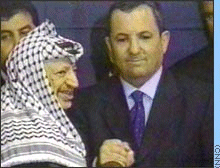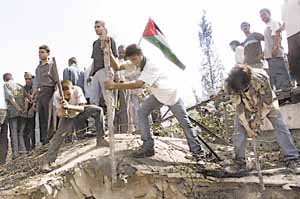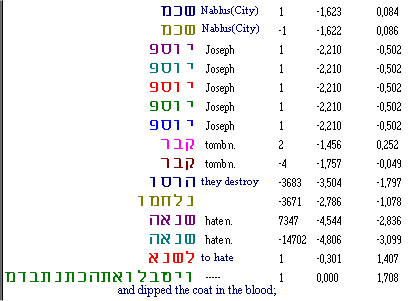Middle East in Crisis
Webmaster note: Dr. Asali has done a commendable job in using neutral language for this matrix and the accompanying article, a task that is difficult to do given the strong feelings by both sides. Please view it as a neutral look at a very difficult topic to cover.
Bitter words and bloody clashes are once again threatening the tentative Middle East peace process. Palestinians and Israelis are each blaming the other for a new round of violence following a September 28 visit by Israeli opposition (Likud) leader Ariel Sharon to a contested religious site in east Jerusalem (al Aqsa or the Temple Mount). What may seem like a small matter to an outsider represents much more to many in the volatile region. As they struggle to find a way for their people to coexist, Palestinian leader Yasser Arafat and Israeli Prime Minister Ehud Barak must contend not only with the political pressures of the moment but also with a lengthy history of conflict.
NABLUS (October 8) - Scores of Palestinians stormed into the Joseph's Tomb compound in Nablus and completely destroyed the site.

|
The path to peace runs through a history of tumultBitter words and bloody clashes are once again threatening the tentative Middle East peace process. Palestinians and Israelis are each blaming the other for a new round of violence following a September 28 visit by Israeli opposition leader Ariel Sharon to a contested religious site in east Jerusalem. |
What may seem like a small matter to an outsider represents much more to many in the volatile region. As they struggle to find a way for their people to coexist, Palestinian leader Yasser Arafat and Israeli Prime Minister Ehud Barak must contend not only with the political pressures of the moment but also with a lengthy history of conflict. The protracted dispute has its origins in events long before Zionist leader David Ben-Gurion declared Israel a state on May 14, 1948, following a U.N. partition of Palestine into Arab and Jewish states. The region -- bounded on the east by the Jordan River, on the west by the Mediterranean, on the north by Lebanon, and on the south by the Sinai Peninsula -- has been the scene of bitter struggles for millennia. Though the region has been known informally as Palestine for 2,000 years, none of its several rulers after the Romans regarded it as a separate administrative entity in its own right. In Jewish tradition, the people of Israel are the descendants of the Old Testament patriarchs Abraham, Isaac and Jacob; but the roots of the present dispute can be traced to the Zionist movement in the late 19th century to colonize a Jewish homeland in Palestine, which at that time had been part of the Ottoman Empire since 1516. During the years before World War I, Zionists established dozens of colonies in Palestine amidst a population that was largely Arab and Muslim. At the same time, Arab nationalism was beginning to surface in opposition to Ottoman rule, and many Arab leaders wanted to end Jewish immigration and land acquisitions.
The British legacyThe struggle intensified at the end of the war when Britain's occupation of Palestine became a mandate ultimately sanctioned by the League of Nations. Incorporated into the mandate was the Balfour Declaration, issued in late 1917 by British Foreign Secretary Arthur Balfour, who endorsed the idea of a Jewish homeland in Palestine (but not, the declaration stipulated, at the expense of the Palestinian Arabs). The British also had promised to help Arab leaders create their own independent states in return for their support against the Ottoman Empire. But a misunderstanding arose that would have longstanding implications: The Arabs thought Palestine would be among the newly independent Arab states. The British said that was not what they intended, but neither did they intend for Palestine to be exclusively a Jewish state. Rather, they said, a Jewish state would exist within Palestine. The British did lay the foundation of a separate Arab state in 1921. It reserved lands east of the Jordan River -- or Transjordan, three-quarters of the Palestine mandate -- exclusively for Arabs and transferred control to the Hashemite family. Now called Jordan, the region gained full independence from Britain in 1946. By the 1930s, tensions in the remainder of the Palestine mandate continued to test British resolve, and in 1937 they declared martial law. That same year a British commission recommended that the rest of Palestine be partitioned into Jewish and Arab states, with the British controlling Jerusalem. The Zionists accepted the idea, albeit reluctantly. The Arabs, enraged that they might be forcibly removed from the proposed Jewish state, rejected it. And with World War II on the horizon, the British government realized it would need Arab support in the Middle East and thus put the idea aside. After the war, as Holocaust survivors and other Jewish displaced persons streamed toward Palestine, the partition idea was revived, this time in the United Nations. In November 1947 the United Nations voted to end the British Mandate by May 15, 1948, and to partition Palestine into Jewish and Arab states, with Jerusalem an international city. Against the oddsJews in Palestine and elsewhere readily accepted the partition. The response by Palestine's neighbors was overwhelmingly negative. Intent on preventing any Jewish entity in the region, they rejected the plan, and in what was to be precursor to many more wars, the armies of Lebanon, Syria, Jordan, Egypt and Iraq invaded the new country with the declared intent of destroying it. Against the odds, the Israelis held their ground. By July 1949 Israel had repulsed the invasion, joined the United Nations, and been recognized by more than 50 governments around the world. In a series of armistices with Egypt, Jordan, Syria and Lebanon in 1949, Israel established borders similar to those of Palestine during the British Mandate. Jordan retained the West Bank of the Jordan River, and Jerusalem was divided under Israeli and Jordanian rule. Subsequent wars were launched by both sides over the next 35 years -- in 1973 by Israel's Arab neighbors and by Israel in 1956 and in 1982's invasion of Lebanon. The most dramatic of all was the Six-Day War, June 5-10, 1967. Responding to what it perceived as imminent attack by Egypt, Syria and Jordan, Israel launched a preemptive strike against all three. Israel won stunning victories on all fronts, taking the Sinai and Gaza from Egypt, the Golan Heights from Syria, and the West Bank from Jordan (including the Old City of Jerusalem).
|
|
Yitzhak Rabin's legacy A sobering thought for Israel's current prime minister, Ehud Barak, as he attempts to find peace with the Palestinians is that Rabin's policy of reconciliation led to his assassination by a right-wing extremist. It was Rabin, prime minister from 1974-1977 and 1992-1995, who initiated the withdrawal of Israeli troops from southern Lebanon, signed a treaty with Jordan and showed a willingness to engage in dialogue with Arafat's Palestine Liberation Organization. A series of Palestinian uprisings in 1985 also convinced Rabin that the continued occupation of Gaza and the West Bank was not in Israel's long-term interest. |

Palestinian leader Yasser Arafat and Israeli Prime Minister Yitzhak Rabin at a meeting in Casablanca in 1994. |
|
Despite the pressure on Barak to make few concessions to the Palestinians, his moderate stance is in direct contrast to that of his predecessor, Benjamin Netanyahu. Benjamin Netanyahu, a conservative, was Israeli prime minister from 1996 until May 1999, when he was voted out of office. His strong stance did little to further the peace process and even prompted the late Syrian president Hafez Assad to halt talks with Israel in 1996. |
|

Despite this display of cordiality, Arafat and Israeli Prime Minister Ehud Barak could not agree on the primary issue of control and sovereignty of Jerusalem once they began their talks at Camp David in July 2000. |
Two years later came talks in Wye, Maryland, between Netanyahu and Arafat, with U.S. President Bill Clinton and an ailing King Hussein of Jordan acting as mediators. In the accord that followed, the Palestinians agreed to remove language from their founding charter that called for the dismantling of the Jewish state, and the Israelis agreed to cede an additional 13 percent of the West Bank. At the same time they set a deadline of September 13, 2000, to reach a final peace accord. By mid-year 2000, with the deadline approaching and no agreement in sight, Clinton invited Barak and Arafat to a three-way summit at Camp David, the presidential retreat in Maryland. The talks began July 11 and ended 15 days later with no agreement in sight, the two sides at an impasse largely over the sovereignty and control of Jerusalem. |
The matrix starts at Genesis 6:21 and ends at Exodus 27:21
Central Term"INTIFADHA" at ELS
-3675
Matrix 1a
 |
Encoded Words : INTIFADHA  NABLUS (October 8) - Scores of Palestinians stormed into the Joseph's Tomb compound in Nablus and completely destroyed the site. |
| Yom Kippur Yom Kippur began Sunday evening, Oct. 8, and continued until Monday evening, Oct. 9, 2000. |
 |
Encoded Words :  |

|

|

|
 |
Webmaster observations: Ariel and Sharon are not close to each other, and the word for responsible is not close to Ariel, Sharon, or Israel. Therefore, one has to conclude that from the matrix they are not responsible (or not proven yet). An objective observer might note that it would be a good idea to look for the PLO and Arafat in the matrix to see if they cross the word for responsible (akhray).
|
matrix R-value for the A matrix is 12.164 ( without ELS of +1) expected number of occurrences for the main term in the Torah for the ELS range of -3675 to + 3675, which was:(2) Antilog 12.164 =1,458,814,260,275 Divided by 2 = 7,294,0713,0137 The statistic chance of the Matrix is 1 chance in 729,407,130,137 This translates into odds of (0,0000000000013 ) Webmaster note: My calculation of
terms ignoring the +1 terms, and using the text R-value of the
main/center term |
Return to Hebrew matrix index page